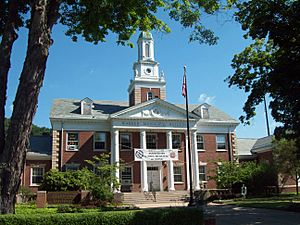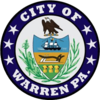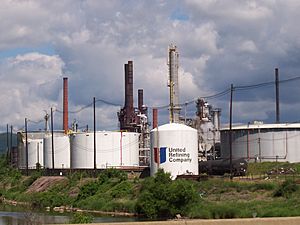Warren, Pennsylvania facts for kids
Quick facts for kids
Warren, Pennsylvania
|
|||
|---|---|---|---|

Warren Municipal Building in Warren in July 2012
|
|||
|
|||
| Etymology: General Joseph Warren | |||
| Motto(s):
"On the Banks of the Allegheny"
|
|||

Location of Warren in Warren County, Pennsylvania (left) and of Warren County in Pennsylvania (right)
|
|||
| Country | United States | ||
| State | Pennsylvania | ||
| County | Warren | ||
| Founded | 1795 | ||
| Area | |||
| • Total | 3.09 sq mi (8.00 km2) | ||
| • Land | 2.91 sq mi (7.54 km2) | ||
| • Water | 0.18 sq mi (0.46 km2) | ||
| Elevation | 1,210 ft (370 m) | ||
| Population
(2020)
|
|||
| • Total | 9,404 | ||
| • Estimate
(2023)
|
9,125 | ||
| • Density | 3,043/sq mi (1,175.5/km2) | ||
| Time zone | UTC-5 (EST) | ||
| • Summer (DST) | UTC-4 (EDT) | ||
| ZIP Code |
16365
|
||
| Area code(s) | 814 | ||
| FIPS code | 42-81000 | ||
| Website | www.cityofwarrenpa.org | ||
Warren is a city in Pennsylvania, United States. It is the main city of Warren County. The city is located along the Allegheny River. In 2020, about 9,404 people lived there.
Warren is home to important offices. These include the headquarters for the Allegheny National Forest and the Cornplanter State Forest. It is also where the Chief Cornplanter Council is based. This is the oldest continuously active Boy Scouts of America Council. The catalog company Blair also has its main office in Warren.
Contents
History of Warren
Long ago, the Seneca nation of Native Americans lived in the Warren area. In 1749, French explorers claimed this land. They buried special markers to show it was theirs. But after the French and Indian War, the British took control.
After the Revolutionary War, two men, General William Irvine and Andrew Ellicott, were sent to plan a town. This happened in 1795. The town was named after Major General Joseph Warren.
The first building in Warren was a storehouse. It was built in 1796 by the Holland Land Company. The first person of European descent to live there permanently was Daniel McQuay from Ireland.
From 1810 to 1840, cutting down trees was the main business. There was a lot of wood and easy access to the river. This made it simple to float lumber down the Allegheny River to Pittsburgh.
In 1875, David Beaty found oil in Warren. He was drilling for natural gas in his wife's flower garden. After this, oil became very important to the city's economy. Many large Victorian homes in Warren were built with money from the oil and timber industries.
A company called Pittsburgh-Des Moines used to be in Warren. This company made the famous Gateway Arch in St. Louis. They also made tanks for railroad cars and other metal structures.
Warren has faced tough economic times. Its population has slowly gone down since 1940. The city is working on a project called "Impact Warren." This project aims to improve the downtown area along the river. It will include new homes, shops, and a convention center.
Many companies are major employers in Warren today. These include Walmart, United Refining Company, Northwest Bank, and Blair Corporation.
Several historic buildings in Warren are listed on the National Register of Historic Places. These include the Warren Historic District and the Struthers Library Building.
Geography and Climate
Warren is located where the Allegheny River and the Conewango Creek meet. The Conewango Creek flows from New York state into Warren. The Allegheny Reservoir and Kinzua Dam are also nearby.
Warren covers about 3.1 square miles (8.0 square kilometers). Most of this area is land. A small part, about 0.2 square miles (0.46 square kilometers), is water.
The Allegheny River, from the Kinzua Dam to Warren, is a "Recreational Waterway." This means it's a great place for fun activities like boating.
Weather in Warren
| Climate data for Warren, Pennsylvania (1991–2020 normals, extremes 1896–present) | |||||||||||||
|---|---|---|---|---|---|---|---|---|---|---|---|---|---|
| Month | Jan | Feb | Mar | Apr | May | Jun | Jul | Aug | Sep | Oct | Nov | Dec | Year |
| Record high °F (°C) | 74 (23) |
74 (23) |
83 (28) |
92 (33) |
95 (35) |
98 (37) |
102 (39) |
100 (38) |
100 (38) |
90 (32) |
84 (29) |
74 (23) |
102 (39) |
| Mean daily maximum °F (°C) | 32.6 (0.3) |
35.2 (1.8) |
44.3 (6.8) |
58.3 (14.6) |
69.8 (21.0) |
77.4 (25.2) |
81.3 (27.4) |
80.4 (26.9) |
74.0 (23.3) |
60.8 (16.0) |
47.9 (8.8) |
37.2 (2.9) |
58.3 (14.6) |
| Daily mean °F (°C) | 25.2 (−3.8) |
26.5 (−3.1) |
34.2 (1.2) |
46.4 (8.0) |
57.5 (14.2) |
66.0 (18.9) |
70.0 (21.1) |
69.0 (20.6) |
62.7 (17.1) |
50.9 (10.5) |
39.9 (4.4) |
30.7 (−0.7) |
48.2 (9.0) |
| Mean daily minimum °F (°C) | 17.8 (−7.9) |
17.7 (−7.9) |
24.2 (−4.3) |
34.4 (1.3) |
45.2 (7.3) |
54.5 (12.5) |
58.7 (14.8) |
57.7 (14.3) |
51.5 (10.8) |
40.9 (4.9) |
32.0 (0.0) |
24.3 (−4.3) |
38.2 (3.4) |
| Record low °F (°C) | −26 (−32) |
−34 (−37) |
−24 (−31) |
0 (−18) |
20 (−7) |
29 (−2) |
36 (2) |
35 (2) |
26 (−3) |
14 (−10) |
1 (−17) |
−22 (−30) |
−34 (−37) |
| Average precipitation inches (mm) | 3.64 (92) |
2.77 (70) |
3.26 (83) |
4.13 (105) |
4.29 (109) |
4.66 (118) |
4.76 (121) |
4.07 (103) |
3.95 (100) |
4.02 (102) |
3.62 (92) |
3.81 (97) |
46.98 (1,193) |
| Average snowfall inches (cm) | 18.2 (46) |
14.9 (38) |
10.0 (25) |
2.4 (6.1) |
0.0 (0.0) |
0.0 (0.0) |
0.0 (0.0) |
0.0 (0.0) |
0.0 (0.0) |
0.1 (0.25) |
7.5 (19) |
18.5 (47) |
71.6 (182) |
| Average precipitation days (≥ 0.01 in) | 19.1 | 14.5 | 14.6 | 15.1 | 14.1 | 13.7 | 13.0 | 11.5 | 11.5 | 15.0 | 15.3 | 17.7 | 175.1 |
| Average snowy days (≥ 0.1 in) | 11.0 | 8.6 | 5.5 | 1.4 | 0.0 | 0.0 | 0.0 | 0.0 | 0.0 | 0.2 | 3.5 | 8.1 | 38.3 |
| Source: NOAA | |||||||||||||
Population Trends
| Historical population | |||
|---|---|---|---|
| Census | Pop. | %± | |
| 1840 | 737 | — | |
| 1850 | 1,013 | 37.4% | |
| 1860 | 1,738 | 71.6% | |
| 1870 | 2,014 | 15.9% | |
| 1880 | 2,810 | 39.5% | |
| 1890 | 4,332 | 54.2% | |
| 1900 | 8,043 | 85.7% | |
| 1910 | 11,080 | 37.8% | |
| 1920 | 14,272 | 28.8% | |
| 1930 | 14,863 | 4.1% | |
| 1940 | 14,891 | 0.2% | |
| 1950 | 14,849 | −0.3% | |
| 1960 | 14,505 | −2.3% | |
| 1970 | 12,998 | −10.4% | |
| 1980 | 12,146 | −6.6% | |
| 1990 | 11,122 | −8.4% | |
| 2000 | 10,259 | −7.8% | |
| 2010 | 9,710 | −5.4% | |
| 2020 | 9,404 | −3.2% | |
| 2023 (est.) | 9,125 | −6.0% | |
| Sources: | |||
In 2000, there were 10,259 people living in Warren. About 23.1% of the population was under 18 years old. The average age in the city was 39 years.
Sports in Warren
Warren has been home to minor league baseball teams. These are teams that play below the major leagues.
- In 1895, a team simply called "Warren" played in the Iron and Oil League.
- From 1908 to 1916, teams like the Warren Blues and Warren Warriors played. They were part of the Interstate League.
- In 1940 and 1941, the Warren Redskins and Warren Buckeyes played. The Redskins were even connected to the Cleveland Indians team in 1940.
These teams played their home games at Russell Park.
Education in Warren
The Warren County School District provides public education for students.
- There are four elementary schools: Eisenhower, Sheffield Area, Warren Area, and Youngsville.
- There is one middle school: Beaty-Warren.
- Three schools serve both middle and high school students: Eisenhower, Sheffield Area, and Youngsville.
- There is one high school: Warren Area High School.
Northern Pennsylvania Regional College (NPRC) is a college that started in 2017. It offers degrees and certificates.
The Warren County Career Center helps students learn job skills. It offers training in many different fields. Students from grades 10 to 12 can attend.
Notable People from Warren
Many interesting people have come from Warren:
- Earl Hanley Beshlin – a former U.S. Congressman.
- Joe Brown – a professional baseball player for the Baltimore Orioles.
- William F. Clinger – another former U.S. Congressman.
- Alice Isabel Hazeltine – a well-known librarian, editor, and writer.
- Art Johnson – a baseball player.
- Ed O'Neil – an NFL player and All-American.
- Tom Tellmann – a professional baseball player for teams like the Milwaukee Brewers.
See also
 In Spanish: Warren (Pensilvania) para niños
In Spanish: Warren (Pensilvania) para niños





